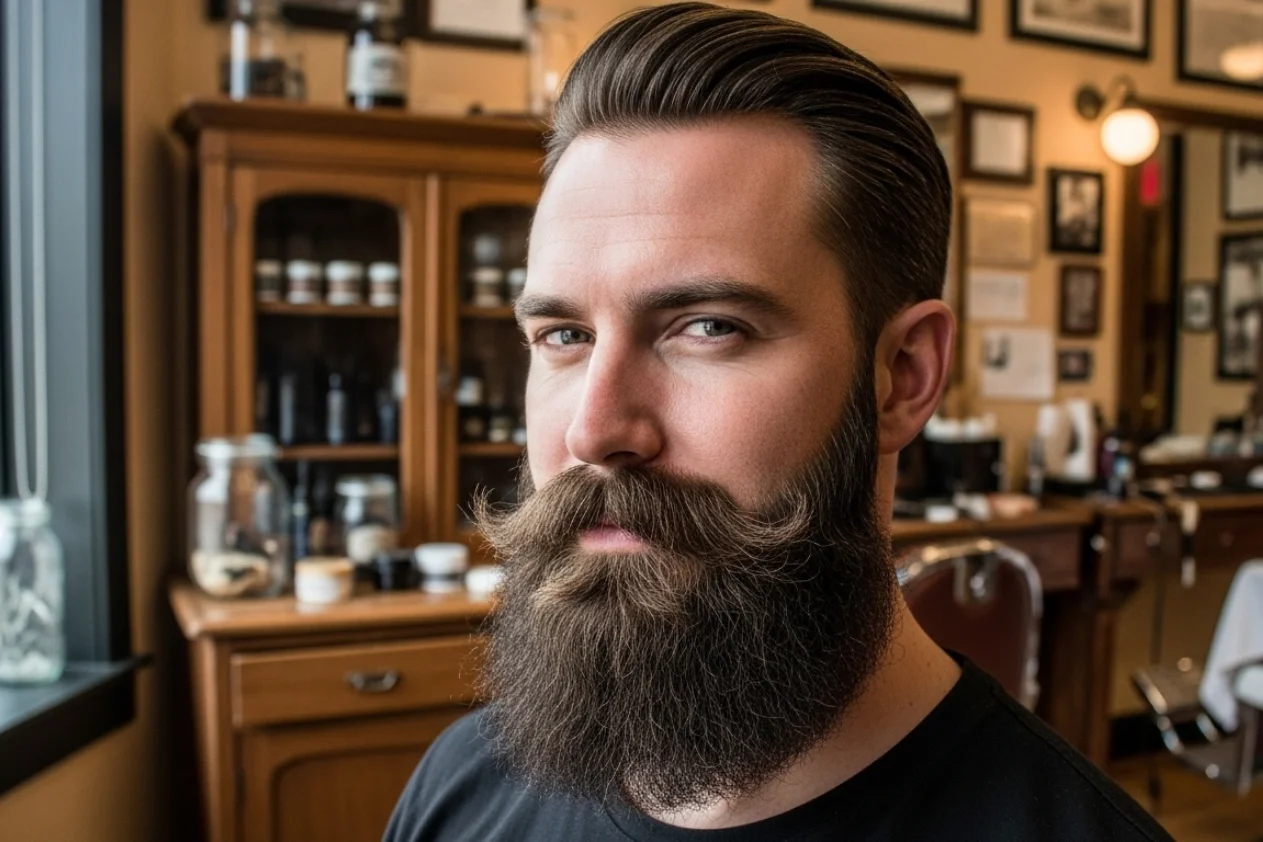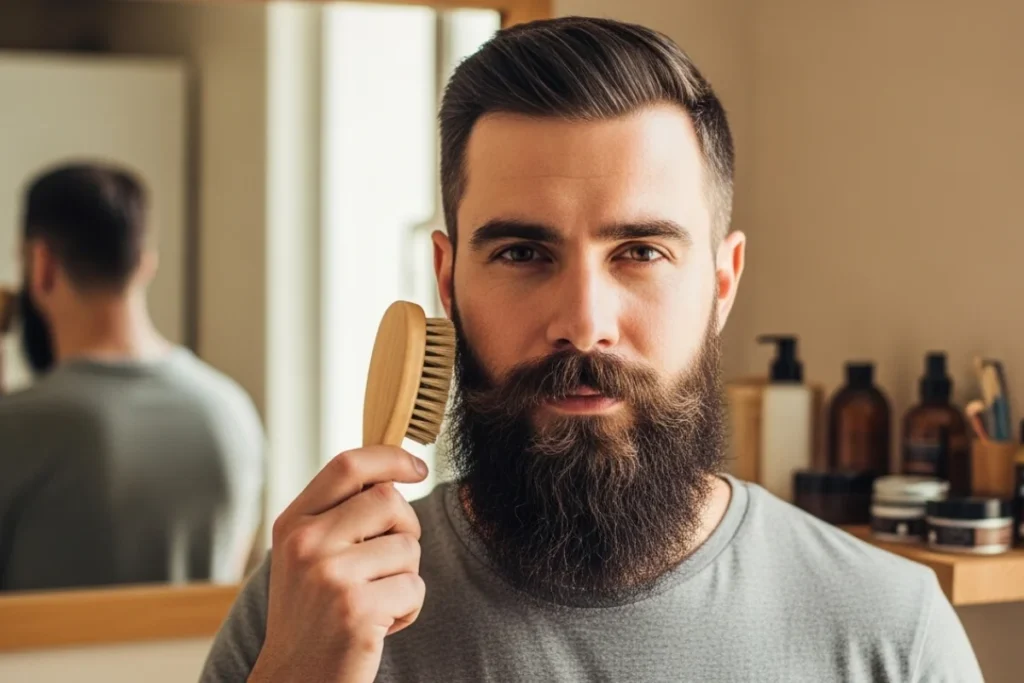

How to train a beard to grow straight. Many men struggle with curly, wavy beard hair that grows in every direction except the one they desire. You can tame unruly beard hair and straighten curly beard with consistent effort and the right techniques.
Here are practical methods that work for controlling rebellious facial hair. You don’t need expensive tools or complicated routines. Just simple strategies you can start using today.
Understanding beard hair structure and growth patterns is essential. Beard hair grows curlier than head hair due to several factors.
It’s important to distinguish between hair texture and growth direction. While you can’t permanently change your natural hair texture without chemical treatments, you can train your beard to grow in a more desirable direction over time.
Think of it like training a plant to grow toward sunlight. With consistent guidance, your beard hairs can learn to follow the path you set for them.

Regular brushing is the foundation of beard training. This simple daily habit, known as the beard brushing technique, helps align beard hairs and encourages them to grow in your preferred direction, a key aspect of natural beard straightening.
For best results, brush your beard when it’s slightly damp, not soaking wet, but not completely dry either. This makes the hair more pliable and receptive to directional training.
Not all brushes are created equal when it comes to beard training. A high-quality boar bristle brush is your best option for several reasons and ranks among the essential beard grooming tools.
Boar bristles distribute your natural oils (sebum) throughout your beard, conditioning it naturally while providing the right amount of tension to train hairs.
Avoid plastic brushes, which can create static and damage your beard. Instead, invest in a brush specifically designed for facial hair, one of the most important beard styling products you can own.
Always brush in the direction you want your beard to grow, typically downward and slightly outward from the center of your face.
Start at the roots and work your way to the tips with slow, deliberate strokes. This trains the hair from its base rather than just styling the ends.
For areas with particularly stubborn growth patterns, spend extra time brushing those sections. Consistency is key to seeing results.
Brush your beard 2-3 times daily. Do it morning and evening, with a midday touch-up when you can. This routine takes several weeks to change growth direction.
Despite what you might hear among common beard myths and the facts, brushing alone won’t permanently straighten curly hair. However, it’s far more effective than most heat styling methods for beards when it comes to training growth direction naturally and safely.
Beard products work alongside your brushing routine. They keep hair in place and nourish it at the same time.
Beard oil is your first line of defense against stubborn, wiry hairs. By softening the beard, oil makes it more receptive to directional training.
Apply 3-5 drops of quality beard oil to your palms, then work it through your beard from roots to tips. Focus on even distribution rather than quantity.
Apply oil to your beard while it’s still damp from the shower. Your hair cuticles are open, so the oil soaks in better.
While oils soften, balms and butters provide the hold necessary to train your beard. These products contain natural waxes that help maintain your desired shape throughout the day.
Sweet Comb Chicago’s mustache and beard wax offers excellent hold without the stiffness of synthetic products. The natural beeswax formula provides just enough structure to train beard hairs while keeping them nourished.
Application technique matters as much as the products themselves:
Heat styling isn’t just for the hair on your head; it’s remarkably effective for training beard growth direction, too.
A blow dryer can help reset the hydrogen bonds in your beard hair, temporarily altering its natural curl pattern and training it to lie in your preferred direction.
Always use the lowest effective heat setting on your blow dryer. High heat might give immediate results, but it damages your beard in the long run.
Most men find that medium heat provides enough styling power without risking beard damage. If your dryer has a cool shot button, use it at the end to set your style.
Never skip heat protectant when using a blow dryer on your beard. A few drops of beard oil can serve this purpose, creating a barrier between your hair and the heat.
Limit heat styling to 2-3 times per week to prevent damage. On non-blow-dry days, rely on your brushing routine and styling products to maintain direction.
If you notice your beard becoming dry or brittle, reduce your blow-drying frequency and increase conditioning treatments to restore moisture balance.
Remember that heat styling provides temporary results that become more permanent with consistent training over time. Be patient with the process.
What you do before bed can significantly impact your beard’s training progress. Nighttime is prime time for beard training because your facial hair has hours to set in your desired direction.
Think of overnight training as the beard equivalent of orthodontic braces; gentle, consistent pressure applied over an extended period produces lasting directional changes.
Apply a slightly heavier amount of beard oil or balm than you would during the day. This overnight conditioning treatment softens stubborn hairs while you sleep.
Sweet Comb Chicago’s beeswax beard conditioner works exceptionally well for overnight training, providing both nourishment and gentle hold to guide growth direction.
For enhanced conditioning, consider using a dedicated beard mask or deep conditioner once weekly. These intensive treatments make beard hairs more pliable and receptive to training.
Beard bands are elastic straps that wrap around your beard, holding it in place overnight in your desired shape and direction.
To use a beard band effectively, apply your styling products, brush your beard into your preferred shape, then secure the band around your beard before sleep.
If you don’t have a dedicated beard band, a clean bandana or microfiber headband can serve as an effective alternative for overnight training.
Your sleeping position affects how your beard grows. Back sleeping is ideal, as it minimizes friction and compression that can undo your training efforts.
If you’re a side sleeper, consider using a silk or satin pillowcase. These smooth fabrics create less friction against your beard, helping maintain your desired direction.
Avoid sleeping with your beard tucked under your chin or pressed against your chest, as this trains your beard to grow in undesirable directions.
Strategic trimming is often overlooked but crucial for training beard growth. The right trimming approach can encourage hair to grow in your preferred direction.
The scruffier your beard, the sharper you need to dress. The same principle applies to beard maintenance; a well-trimmed beard is easier to train.
Every beard has problem spots that resist training. For these areas, more frequent trimming helps reset the growth pattern.
The jawline and neck often feature the most directional challenges. Consider keeping these areas slightly shorter while you focus on training them.
For extremely stubborn patches, a combination approach works best: daily brushing, product application, and more frequent trimming until the area begins cooperating.
Once you’ve established your desired growth pattern, maintenance trimming becomes essential. Aim for a light trim every 2-3 weeks.
Focus on maintaining the shape that supports your directional training. Avoid dramatic style changes that might undo your progress.
Remember that new growth will always follow your beard’s natural tendencies, so ongoing training is necessary even after you’ve achieved your desired direction.

Consistency is the secret ingredient in successful beard training. A daily routine combines multiple methods for maximum effectiveness.
Even with the best intentions, many men sabotage their beard training efforts with these common mistakes.
Inconsistency is the biggest culprit. Training your beard is like training a muscle; sporadic efforts produce minimal results.
While blow-drying helps train your beard, excessive heat damages hair and can make it more resistant to training.
Limit heat styling to 2-3 times weekly, and always use heat protectant products like beard oil before applying heat.
Consider alternating between heat styling and air-drying to give your beard recovery time between heat exposures.
Dehydrated beard hair is brittle and resistant to training. Ensure you’re drinking enough water and using hydrating beard products.
Sweet Comb Chicago’s men’s grooming products are formulated with natural ingredients that hydrate effectively without weighing down your beard.
Beard training requires patience. Many men give up before seeing results, not realizing that significant changes take 4-6 weeks of consistent effort.
Track your progress with weekly photos rather than daily mirror checks. This provides a more accurate picture of your training success.
Remember that you’re working with your body’s natural growth cycles. New hairs emerging from follicles will gradually adopt your trained direction.

Training your beard to grow straight isn’t an overnight transformation; it’s a journey that rewards consistency and patience.
By implementing these five proven methods, daily brushing, using the right products, strategic heat styling, overnight training, and proper trimming, you’ll gradually notice your beard becoming more manageable and growing in your desired direction.
Remember that beard training works with your natural hair, not against it. While you can’t thoroughly change your beard’s inherent texture, you can significantly improve its growth direction with dedicated effort.
For best results, incorporate Sweet Comb Chicago’s natural beeswax-based products into your routine. Their mustache and beard styling wax provides excellent hold without harsh chemicals, making it ideal for long-term beard training.
Stay committed to your routine, adjust techniques as needed for your unique beard, and enjoy the process of mastering your facial hair. With time and proper care, even the most unruly beard can be trained to grow straighter and more manageable.

Founder of Sweet Comb Chicago
